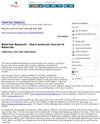绿色炼铁工业:利用石灰污泥生产铁球团
IF 1.3
4区 材料科学
Q4 MATERIALS SCIENCE, MULTIDISCIPLINARY
Materials Research-ibero-american Journal of Materials
Pub Date : 2023-05-01
DOI:10.1590/1980-5373-mr-2022-0205
引用次数: 0
摘要
本文章由计算机程序翻译,如有差异,请以英文原文为准。
Green Ironmaking Industry: Production of Iron Pellets Using Lime Sludge
The use of alternative raw materials is essential for establishing a circular economy in the mineral and ironmaking sectors. Therefore, this study investigates the potential of lime sludge as fluxing material during pelletization and proposes an alternative route for the usage of waste. The pellets were manufactured with different binary basicity values (CaO/SiO 2 ) (0.15–0.45) and bentonite (0.5–0.7 wt%) and fixed carbon (0.5–1.1 wt%) contents. The results demonstrated that lime sludge has significant potential for application in pelletization. Pellet quality was evaluated using drop number, mechanical strength, tumble index, porosity, and kinetic analyses. Pellets with the optimal composition using lime sludge withstood 3.6 drops/pellet, a tumble test of 1.57 wt.%, and a mechanical strength test of 214.83 kgf/pellet and exhibited a porosity of 31.28%. Lime sludge did not influence the reducibility of the iron-ore pellets. In the temperature range of 800–900 °C, the reaction was controlled by diffusion, with E a between 179.89 and 233.10 kJ/mol.
求助全文
通过发布文献求助,成功后即可免费获取论文全文。
去求助
来源期刊

Materials Research-ibero-american Journal of Materials
MATERIALS SCIENCE, MULTIDISCIPLINARY-
CiteScore
2.40
自引率
11.80%
发文量
161
审稿时长
3 months
期刊介绍:
Information not localized
 求助内容:
求助内容: 应助结果提醒方式:
应助结果提醒方式:


